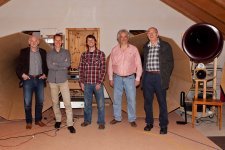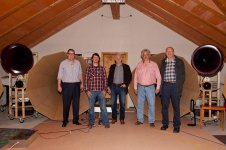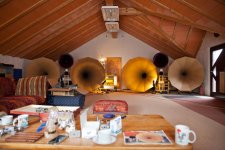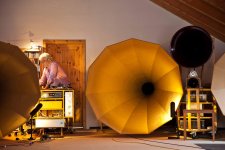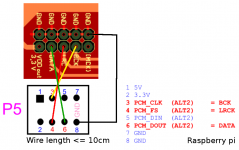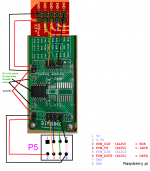What is the strategy for the screen drilling ?
Is it mounted behind the 10mm panel, or is the panel reduced around the screen's window ?
Is there a protection to mount before the screen ?
If somebody is interested in a custom transformer for both 5V and 12V (drop in replacement on Doede's power boards), PM me : I have one piece not exactly to my needs and it'll be cheap (for 230V countries).
Is it mounted behind the 10mm panel, or is the panel reduced around the screen's window ?
Is there a protection to mount before the screen ?
If somebody is interested in a custom transformer for both 5V and 12V (drop in replacement on Doede's power boards), PM me : I have one piece not exactly to my needs and it'll be cheap (for 230V countries).
Using LCD display to show status of input selected, and for USB input will display music playing the sample rate ;-)
It is mounted directly on the back of the panel and it fitted in those pictures. Panel thickness is not reduced, I will post more pics with it powered up once done
It is mounted directly on the back of the panel and it fitted in those pictures. Panel thickness is not reduced, I will post more pics with it powered up once done
Testing of different DDDAC 1794 designs
Hi,
Yesterday we had a meeting for a comparison of different DDDAC’s at Klaus his system in Lindlar (near Cologne) in Germany.
It was an international gathering of audio enthusiasts from Germany, Great Britain and The Netherlands: Rheinhard (rhlauranna), Klaus, James (dwjames), Ian, Hans (owner of: http://www.musicalaffairs.com/), Cees “the Guru” Pel (from Pel Audio), and me.
We had some nice discussions on audio and have enjoyed listening to Klaus his nice system with the different dacs.
Dacs we listened to:
1) Klaus’s Standard Single board DDDAC1794 with 2,2uf Mundorf single ended outputs with Bernt’s big power supply
2) Rheinhards Standard 4 board DDDAC1794 with 2,2uf Mundorf single ended outputs with Bernt’s big power supply
3) James's single board DDDAC1794 with Tent Shunts, 2,2uf standard caps single ended output, standard IV resistors, and modified Doede power supplies as can be seen a few pages back in this thread.
4) James's single board DDDAC1794, direct balanced output.
5) Stefans 4 board DDDAC1794 with local Tent Shunts, Salas shunt power supplies, single ended output with Audio Note (Jensen) copper in foil capacitor of 0,22uf.
6) Stefans 4 board DDDAC1794 with local Tent Shunts, Salas shunt power supplies, balanced output.
7) Stefans 4 board DDDAC1794 with local Tent Shunts, Bernts big power supply, balanced output.
The source was a win PC with Foobar running with Wasapi output to the Wave IO of all dacs.
If I were to select a winner I would say setup 7 sounds best on Klaus his system. This gave the most detail, openness and compactness of the instrumens/voices of all dacs. And the power supply of Bernt brings more weight to the lows and lower mid frequencies that balances nice with Klaus his system. In my home set I would prefer the Salas power supply; this not a quality difference but a sound balance difference we are talking about; both supplies have their merits.
You can also nicely hear the differences between the 1 and 4 board standard dacs, where the latter sounds best.
The surprise of the day was number 4, James his Dac with direct balanced out. This was a nice 2nd place behind number 7. It had most of the openness and detail of 7 and I found it sounding clearly better than the standard 1 and 4 board units. If James changes the I/V resistors to some nice Tantalums than it would be the best dac price wize! Also the changes James has made in the power supply pays off here; well-done James!
During and after dinner we also tried the Raspberry Pi, with connected HDD (through a powered USB hub), through Wave IO and also with the direct I2S output on setup 7. Pi was powered with a linear supply from Tent Labs.
I found the Raspberry Pi through Wave IO nicer than the Win PC.
Switching to I2S direct was also a surprise for all, this was in my opinion the best sounding configuration!
That makes you wonder: the Pi has a crappy clock and the Pi generates the needed frequency itself. The Pi cannot even generate the exact frequency of 44.1Khz (the onboard clock is 19.2MHz so the closest division will be 192Mhz/435=44.137Khz) Also the ground of the Pi will be messy and this is directly coupled with the dac (I think the advantage of going balanced shows here, the ground noise will then be balanced out).
So what is going on here? I presume the Wave IO interface, although it is very good, also introduces jitter due to all the extra handling of the data; first all data needs to be packed into USB packages, sent to Wave IO, unpacked, converted to I2S, reclocked………
So also here the KISS principle is valid: Keep It Simple Stuped!
There is a lot of debate on the direct I2S subject elsewhere on this forum.
I have learned that I will focus in the near future on direct I2S streaming to the dac; as this is the spot where we can gain a lot in sound quality. I firmly believe that a small embedded computer will outperform all Win and Mac systems. This is due to building an OS system that only needs to perform the task of streaming audio; all unnessecay processes are taken out of the OS. And even more because the open source software is originated from audio entheusiasts around the world finding the best way to stream audio and not forced by a business model for making money on software.
And I will change the power supply toroid transformer for a simple EI core transformer. This is a tip from the Guru; a traditional EI core is better sounding (and cheaper!), this is also what the Bernt power supply is using.
The above results are my personal opinion but I think all attendees will agree with me
On attached pictures you can see, from left to right: Cees, Stefan, James, Klaus, Hans
The other picture shows: Rheinhard, James, Cees, Klaus, Hans
Unfortunately Ian was a bit later so he missed the group pictures.
A note on Klaus his system: the listening room is very good, very nice acoustics, the Goto units with front horns are super. If I may comment a bit: I would love to hear this system powered with nice triode tube amplifiers.
@Klaus,
Thank you for inviting us to your home and also for taking care of the inner person with the sausages on the BBQ and the soup!
Hans, Cees and I will be glad to invite you all to come to the Netherlands for a listening session at one of our homes in the future!
Kind regards,
Stefan
Hi,
Yesterday we had a meeting for a comparison of different DDDAC’s at Klaus his system in Lindlar (near Cologne) in Germany.
It was an international gathering of audio enthusiasts from Germany, Great Britain and The Netherlands: Rheinhard (rhlauranna), Klaus, James (dwjames), Ian, Hans (owner of: http://www.musicalaffairs.com/), Cees “the Guru” Pel (from Pel Audio), and me.
We had some nice discussions on audio and have enjoyed listening to Klaus his nice system with the different dacs.
Dacs we listened to:
1) Klaus’s Standard Single board DDDAC1794 with 2,2uf Mundorf single ended outputs with Bernt’s big power supply
2) Rheinhards Standard 4 board DDDAC1794 with 2,2uf Mundorf single ended outputs with Bernt’s big power supply
3) James's single board DDDAC1794 with Tent Shunts, 2,2uf standard caps single ended output, standard IV resistors, and modified Doede power supplies as can be seen a few pages back in this thread.
4) James's single board DDDAC1794, direct balanced output.
5) Stefans 4 board DDDAC1794 with local Tent Shunts, Salas shunt power supplies, single ended output with Audio Note (Jensen) copper in foil capacitor of 0,22uf.
6) Stefans 4 board DDDAC1794 with local Tent Shunts, Salas shunt power supplies, balanced output.
7) Stefans 4 board DDDAC1794 with local Tent Shunts, Bernts big power supply, balanced output.
The source was a win PC with Foobar running with Wasapi output to the Wave IO of all dacs.
If I were to select a winner I would say setup 7 sounds best on Klaus his system. This gave the most detail, openness and compactness of the instrumens/voices of all dacs. And the power supply of Bernt brings more weight to the lows and lower mid frequencies that balances nice with Klaus his system. In my home set I would prefer the Salas power supply; this not a quality difference but a sound balance difference we are talking about; both supplies have their merits.
You can also nicely hear the differences between the 1 and 4 board standard dacs, where the latter sounds best.
The surprise of the day was number 4, James his Dac with direct balanced out. This was a nice 2nd place behind number 7. It had most of the openness and detail of 7 and I found it sounding clearly better than the standard 1 and 4 board units. If James changes the I/V resistors to some nice Tantalums than it would be the best dac price wize! Also the changes James has made in the power supply pays off here; well-done James!
During and after dinner we also tried the Raspberry Pi, with connected HDD (through a powered USB hub), through Wave IO and also with the direct I2S output on setup 7. Pi was powered with a linear supply from Tent Labs.
I found the Raspberry Pi through Wave IO nicer than the Win PC.
Switching to I2S direct was also a surprise for all, this was in my opinion the best sounding configuration!
That makes you wonder: the Pi has a crappy clock and the Pi generates the needed frequency itself. The Pi cannot even generate the exact frequency of 44.1Khz (the onboard clock is 19.2MHz so the closest division will be 192Mhz/435=44.137Khz) Also the ground of the Pi will be messy and this is directly coupled with the dac (I think the advantage of going balanced shows here, the ground noise will then be balanced out).
So what is going on here? I presume the Wave IO interface, although it is very good, also introduces jitter due to all the extra handling of the data; first all data needs to be packed into USB packages, sent to Wave IO, unpacked, converted to I2S, reclocked………
So also here the KISS principle is valid: Keep It Simple Stuped!
There is a lot of debate on the direct I2S subject elsewhere on this forum.
I have learned that I will focus in the near future on direct I2S streaming to the dac; as this is the spot where we can gain a lot in sound quality. I firmly believe that a small embedded computer will outperform all Win and Mac systems. This is due to building an OS system that only needs to perform the task of streaming audio; all unnessecay processes are taken out of the OS. And even more because the open source software is originated from audio entheusiasts around the world finding the best way to stream audio and not forced by a business model for making money on software.
And I will change the power supply toroid transformer for a simple EI core transformer. This is a tip from the Guru; a traditional EI core is better sounding (and cheaper!), this is also what the Bernt power supply is using.
The above results are my personal opinion but I think all attendees will agree with me
On attached pictures you can see, from left to right: Cees, Stefan, James, Klaus, Hans
The other picture shows: Rheinhard, James, Cees, Klaus, Hans
Unfortunately Ian was a bit later so he missed the group pictures.
A note on Klaus his system: the listening room is very good, very nice acoustics, the Goto units with front horns are super. If I may comment a bit: I would love to hear this system powered with nice triode tube amplifiers.
@Klaus,
Thank you for inviting us to your home and also for taking care of the inner person with the sausages on the BBQ and the soup!
Hans, Cees and I will be glad to invite you all to come to the Netherlands for a listening session at one of our homes in the future!
Kind regards,
Stefan
Attachments
Last edited:
4) James's single board DDDAC1794, direct balanced output.
……..
The surprise of the day was number 4, James his Dac with direct balanced out. This was a nice 2nd place behind number 7. It had most of the openness and detail of 7 and I found it sounding clearly better than the standard 1 and 4 board units. If James changes the I/V resistors to some nice Tantalums than it would be the best dac price wize! Also the changes James has made in the power supply pays off here; well-done James!
Stefan
Battle of the DDDAC's!
What were the changes made to James his power supply?
Could you describe the difference between single and multiple boards?
I would suggest using a small isolator board between the pi and the dac, they are cheap and easy to put together - one NVE715-3E isolator chip ($10) and two smt capacitors ($1 max). You power one side from the 3.3vdc in Doede's m-board and the 3.3vdc out from the rpi p5 header for the other side. If you use the diyinhk board (2 for free + $4 shipping) I'd leave the chokes out, I thought it sounded better without them. Try it, you will be happily surprised. I posted previously that I'm using the Acko S03 now, nice improvement over the plain isolator. I'm now getting it changed to a single 100mhz clock (since it's async with the rpi) and LiFePO4 battery powering the clock (instead of the any of the three built-in options for different regulators). Until the BBB cape is done and allows RCK of the BBB, this I think is the best solution if you are using the rpi.Also the ground of the Pi will be messy and this is directly coupled with the dac
This is very true. But at least from the linux side, this can be done with *any* version of linux, not just the ARM based boards. However, the ARM boards have the advantage of low heat, small size and low power consumption - which allows you to place them close to the dac board, since I2S doesn't travel very far.I firmly believe that a small embedded computer will outperform all Win and Mac systems. This is due to building an OS system that only needs to perform the task of streaming audio; all unnessecay processes are taken out of the OS.
Not just the audio stuff, but all open source software, if you don't mind a bit of incovenience when setting things up and reading up fill in the missing documentation, open source is for you!And even more because the open source software is originated from audio entheusiasts around the world
Sorry Doede, end of the OT post.
An externally hosted image should be here but it was not working when we last tested it.
Cees, James, Stefan and Hans "inspecting" some DDDACs 1794 and 1543...
An externally hosted image should be here but it was not working when we last tested it.
James's DDDAC1794 with one deck...
An externally hosted image should be here but it was not working when we last tested it.
Stefan with his "monster tuned" DDDAC1794 with four decks..
An externally hosted image should be here but it was not working when we last tested it.
...in detail...
An externally hosted image should be here but it was not working when we last tested it.
...and the flipside...
An externally hosted image should be here but it was not working when we last tested it.
...the output connections (Furutech), said by Stefan to be "the best"...
An externally hosted image should be here but it was not working when we last tested it.
...Shunts and Tantalums...
An externally hosted image should be here but it was not working when we last tested it.
...shunts on the new mother board...
An externally hosted image should be here but it was not working when we last tested it.
...direct out...
An externally hosted image should be here but it was not working when we last tested it.
...the raspberry pi...
An externally hosted image should be here but it was not working when we last tested it.
Stefan and Hans laying last hands on Stefan's DDDAC1794...
An externally hosted image should be here but it was not working when we last tested it.
...and yes, curiously inspecting all the different stuff...
An externally hosted image should be here but it was not working when we last tested it.
this is another "secret" of Stefan how to finely tune his sound.... personally I was never that much into cables, but this one really impressed me... Stefan, please don't forget you promised me to send me a pair for testing purposes... many thanks in advance...
Last edited:
Hi,
...
Switching to I2S direct was also a surprise for all, this was in my opinion the best sounding configuration!
...
Stefan
hi stefan,
your report encourage to test the rasPi with the dddac. would you (or somebody else) please share a diagram how rasPi shall be connected correctly to the dddac via direct i2s , and if there is any issues/tips need to be considered (grounding issues, any i2s attenuation, etc.) .
by the way, which OS and stream player have you used on rasPi? if the OS was tuned/modified to be mainly dedicated for audio streaming (without the heavy rest of the OS), could you please share the modifications of the OS , so that even non-linux freaks like me can follow
best regards
An externally hosted image should be here but it was not working when we last tested it.
the power supply section of Stefan's DDDAC1794...
An externally hosted image should be here but it was not working when we last tested it.
...Stefan's raspberry pi > wave IO...
An externally hosted image should be here but it was not working when we last tested it.
...and yes, the big winner regarding power supply, Bernd's master achievement, weighing more than 20 kilograms
An externally hosted image should be here but it was not working when we last tested it.
...Stefan and Klaus discussing details...
An externally hosted image should be here but it was not working when we last tested it.
Klaus and Hans feeling well and understanding each other...
An externally hosted image should be here but it was not working when we last tested it.
Stefan, James and Cees arranging the next listening step...
An externally hosted image should be here but it was not working when we last tested it.
...unfortunately Ian from England was a little late because of ferry problems at Rotterdam, but nevertheless was integrated within seconds, and that was especially fun...
An externally hosted image should be here but it was not working when we last tested it.
..Hans streaming music to Klaus's system with Stefan's I-pad, and James feeling very happy with it...
An externally hosted image should be here but it was not working when we last tested it.
Stefan and Klaus looking for certain music tracks... without computer no music at all nowadays...
An externally hosted image should be here but it was not working when we last tested it.
...James soldering on his DDDAC1794...
An externally hosted image should be here but it was not working when we last tested it.
...and yes, concentrated listening from time to time...
An externally hosted image should be here but it was not working when we last tested it.
...and when the boys are hungy, they have to eat something...
An externally hosted image should be here but it was not working when we last tested it.
An externally hosted image should be here but it was not working when we last tested it.
and last not least James and Ian helping me to solder my new power connections for 12 V and 5 Volt within one to my own DDDACs... hey, you both, thanks a million for doing this for me !!!
Last edited:
See images attached.diagram how rasPi shall be connected correctly to the dddac via direct i2s
Install volumio or rune audio on the pi and all the tweaks are already done. You *will* have to read up some on using ssh to connect to the pi unless you hook it up to a monitor for the little hand configuration you have to do. Search back on this thread for what you have to edit in volumio. I have not used rune, but I assume is similar to volumio as they were the same developers that forked their efforts.by the way, which OS and stream player have you used on rasPi? if the OS was tuned/modified to be mainly dedicated for audio streaming
Attachments
See images attached.
Install volumio or rune audio on the pi and all the tweaks are already done. You *will* have to read up some on using ssh to connect to the pi unless you hook it up to a monitor for the little hand configuration you have to do. Search back on this thread for what you have to edit in volumio. I have not used rune, but I assume is similar to volumio as they were the same developers that forked their efforts.
thanks a lot!! i will try that ... i already sent you an email!
regards
hi stefan,
your report encourage to test the rasPi with the dddac. would you (or somebody else) please share a diagram how rasPi shall be connected correctly to the dddac via direct i2s , and if there is any issues/tips need to be considered (grounding issues, any i2s attenuation, etc.) .
by the way, which OS and stream player have you used on rasPi? if the OS was tuned/modified to be mainly dedicated for audio streaming (without the heavy rest of the OS), could you please share the modifications of the OS , so that even non-linux freaks like me can follow?
best regards
Check this: P5 header
And this: building-open-embedded-audio-applicance
I am a Linux noob so do not ask difficult questions on low level software issues
First I used a distribution with mpd build by a friend of mine, later on RaspiFi and now Volumio.
Volumio is very easy to install and use, and has I2S output on the Pi and within the coming months probably also for beagle bone black!
@Palmito,
I think I will wait for the BBB with the Cape from Russ. I expect he can make it nicer than I can
- Home
- Source & Line
- Digital Line Level
- A NOS 192/24 DAC with the PCM1794 (and WaveIO USB input)
